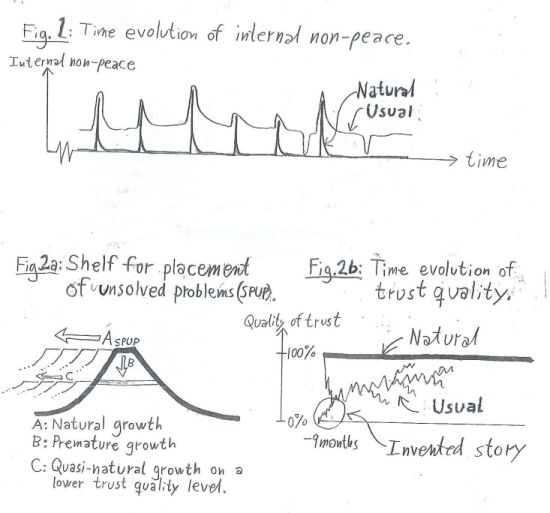The word "natural" in this context has the specific meaning "unloaded by prejudices". The word "usual" is used instead of "/statistically/ normal". There are majority misunderstandings which obscure this such that many people think that various statistically normal phenomena are natural although they are in fact loaded by prejudics.

The diagram displays a natural (thick line) and a usual (thin line) time evolution of the internal non-peace states. In the natural case, the pains of life are affirmatively received and thus promply dissolved. In the usual case, there are unconscious mental processes going on. Their purpose are to avert preconscious or conscious attempt to do something that might awake psycho-traumatised memories of pains of life. Their presence make it more difficult to return to a state of internal peace, thus the background non-zero level of the thin line. There is a common displacement of reference point, what it is to be in internal peace.
The non-zero levels in between the peaks illustrate what instinctual drives in Psychoanalysis are about. The origins of persistant drives are psycho-traumatised adaptation decision (See arrow B of Fig. 2!) which lead to an acquired inability to return to internal peace. Instead of returning to internal peace (and then from a trust position maybe satifying needs or solving problems), a more or less unsuccessful satisfaction-of-needs pursuit prevails.
When a problem or need occurs, one cannot treat it immediately. First an identification of the problem i necessary. This is achieved by metaphorically placing the problem on the Shelf for Placement of Unsolved Problems (SPUP). It is characterised by specifying two degrees of freedom for the trust, its quantity and its quality.
The quality of trust of the SPUP determines the degreee of internal non-peace, to which extent on worries about the possibility of finding a solution or how much one tries to suppress the problem rather than facing it. Some synonymous expressions to "quality of trust" are "qualitative adultness" and "qualitative ability to affirmatively receive the pains of life".
The resting capacity of the SPUP is proportional to the individual's own capacity to form, without pains of life, mental representations of reality, irrespective of their quality. Mental representations are non-chaotic reflexions of reality.
In the sense of Physics, reality is chaotic with order are various levels. The formations of mental representaions are sometimes associated with receiving pains of life, namely when the problem is bigger than the resting capacity of the shelf. For every individual, the initial SPUP (thick line) is of miniscule trust quantity but of perfect trust quality.
The arrows in Fig. 1 show some modes of quantitative growth of the trust.
A: Natural growth: Natural growth is connected with affirmative receipts of pains of life. Since, as the Swedish poet Karin Boye expressed it, "Certainly, it does hurt when buds are bursting. Why should otherwise the spring hesitate?", the individual may need a enough good trust environment in order to dare to perfectly receive the pains of life. If the individual is a child, the necessary empathic nothing-doing help could be provided by physical closeness to an adult person not having unconscious mental processes going on.
The shelf is like a semi-elastic rubber band which the individual stretches horizontally in connection with affirmative receipts of the pains of life. When the crises is over, the shelf contracts, but, as it is semi-elastic, not completely.
Thus the trust quantity is step by step increased while the trust quality is kept uncorrupted.
B: Premature growth: In the absence of empathic nothing-doing support from an enough good trust environment, the individual's own capacity to receive pains of life may be insufficient. One would find onself in internal chaos, a situaion that one necessarily must overcome.
On such occasions, there is an emergency solutions, namely to prematurely extend the shelf. This is done by decreasing the quality of trust with concomitant programming & intiation of unconscious mental precesses, i.e. by acquiring a prejudice. The trust is reestablished but on a lower lever of trust quality. This corresponds to the non-zero background level of internal no-peace in Fig 1.
Another way of describing this premature growth mode is to buy trust quantity by selling out trust quality.
The diagram displays the natural (thick line) and some usual (thin lines) time evolution of the trust quality for a human individual on personal level. The encircled part represents the story that is made up by creators of development fetishistic thories in order to (unconciously) hide and ideologically justify the opression that characterises childhood in our current prehistorical era of minkind. They are development fetishistic in the sense that they confuse true development with development under the constraint of already having internalised complications of life.